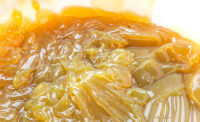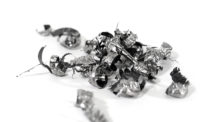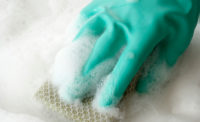Keeping meat and poultry plants and equipment free of pathogens is an arduous undertaking.
While many factors including high employee attrition rates affect the eradication of contaminants, perhaps the biggest obstacle is the abundance of plants and equipment that were built years ago with fewer food safety-related features now common to newer designs.
Such buildings and machinery not only are more likely to harbor contaminants, but they also are often difficult to properly sanitize.
“Meat and poultry processing plants are a potentially rich source of pathogens,” says Larry Keener, president and chief executive officer of Seattle-based International Product Safety Consultants Inc. “The equipment and plants tend be older designs that are not meeting U.S. Department of Agriculture and U.S. Food and Drug Administration expectations for food safety.”
Much technology and plant elements are from an era where there were fewer food safety demands from regulators, he says.
“Equipment being built today is much better than those from the past,” Keener says. “Thirty years ago, Listeria wasn’t even considered a human pathogen and manufacturers would not have taken that organism into consideration with their designs.”
Among the drawbacks of older machines is the greater prospect of trapping food particles and residues around such components as nuts, bolts and screws.
Equipment manufacturers now typically take more steps to enhance food safety, such as by using rounded piping, hermetic welding and stainless steel designs that are more resistant to corrosion than the aluminum and iron that were common in past devices, Keener says.
Yet while equipment often are major sources of pathogens, processing plants also can be troublesome, he says, noting many older facilities have plumbing, electrical conduits, junction boxes, wall finishes and drainage systems that can harbor bacteria.
“Contractors who built the processing equipment and factories were not necessarily specialists with an understanding of food safety,” Keener says.
In addition to focusing on possible contamination when leveraging plants and equipment, operators can better prevent the growth of bacteria by making it easier to sanitize all areas of facilities.
Apparatus, for instance, should be at least 18 to 36 inches above the floor to make it simpler for workers to clean under the equipment, Keener says, noting devices also must be kept away from the corners of facilities for clearer access to the sites.
It also is essential to limit the amount of equipment in each area to reduce the prospect of pathogens spreading among devices, while also reducing the workload of sanitation crews who frequently are understaffed, says Tim Cox, vice president of operations for Cox Consultants Inc., a Bennett, N.C.-based sanitation consultancy that works with meat and poultry operators.
Plant managers, meanwhile, should work closely with chemical suppliers to ensure they are leveraging the most effective cleaning elements for their situations, says Alan Grant, senior manager, food safety management, for NSF International, an Ann Arbor, Mich.-based public health certification and training firm.
It is crucial the suppliers themselves are well versed on the sanitizing needs of each facility, Cox says.
Such companies need to understand the cleaning regulations that plants must follow and the effect specific chemicals will have on contaminants, he says.
Among the most common bacteria in meat and poultry plants is Listeria monocytogenes, which has the ability to grow at temperatures as low as 32 degrees Fahrenheit and can multiply at typical refrigeration temperatures, making it difficult to control, Grant says.
Visibility issues also add to the difficultly of adequately sanitizing all areas of plants, Grant says.
“A combination of hot water and efficient chemicals are needed, but a cold room and hot water creates the additional challenge of having to deal with high levels of fog and condensation during sanitation shifts,” he says.
Additional measures that can enable operators to better deal with the myriad issues is the leveraging of no-rinse sanitizers and having employees clean their work stations with sanitizers in spray bottles throughout their shifts, Grant says.
Plants also can follow the North American Meat Institute’s principles of sanitary design, which includes color coding equipment to identify high- and low-risk cleaning areas and using easy-to-clean construction materials for production areas, walls and floors, he says.
“Plant operators also should gradually replace older equipment with upgraded models that can be easily disassembled for better cleaning and sanitation access,” Grant says, adding “it is also important to communicate expectations to the equipment suppliers.”
For maximum sanitizing effectiveness, meanwhile, food safety experts should be active in the creation and implementation of equipment and facilities, Cox states.
“We often are not including people who are responsible for the cleaning and sanitizing in the development processes,” he says. “This lack of proper sanitary design is driving many of the food processing challenges.”
More designers, however, are hiring food safety authorities to address the wide range of sanitizing requirements, such as the use of ventilation systems to combat the transfer of pathogens through air movement, Keener says.
“Understanding the impact of air quality on food safety is an emerging and important concern,” he says.
Industry interest in plant-friendly cleansers also is becoming more prevalent, Grant adds.
“We can expect an increase in demand for biodegradable cleaning and sanitizing chemicals to help ensure greater sanitization,” he says.
To minimize the risk of foodborne illness, it is crucial for processors to give proper attention to all aspects of sanitation in meat and poultry facilities, Cox says.
“There must be commitment from upper management that they will do as much as possible to make sure the equipment and plant designs do not cause the sanitation department to flounder,” he says. “There must be managers who understand how sanitation is supposed to function in the environment and the elements that can impact the plants’ ability to operate cost effectively.” NP
10 Principles of Sanitary Design
1. Cleanable to a Microbiological Level
Food equipment must be constructed to ensure effective and efficient cleaning over the life of the equipment. The equipment should be designed as to prevent bacterial ingress, survival, growth and reproduction on both product and non-product contact surfaces of the equipment.
2. Made of Compatible Materials
Construction materials used for equipment must be completely compatible with the product, environment, cleaning and sanitizing chemicals and the methods of cleaning and sanitation.
3. Accessible for Inspection, Maintenance, Cleaning and Sanitation
All parts of the equipment shall be readily accessible for inspection, maintenance, cleaning and sanitation without the use of tools.
4. No Product or Liquid Collection
Equipment should be self-draining to assure that liquid, which can harbor or promote the growth of bacteria, does not accumulate, pool or condense on the equipment.
5. Hollow Areas Should be Hermetically Sealed
Hollow areas of equipment such as frames and rollers must be eliminated wherever possible or permanently sealed. Bolts, studs, mounting plates, brackets, junction boxes, nameplates, end caps, sleeves and other items must be continuously welded to the surfaces, not attached via drilled and taped holes.
6. No Niches
Equipment parts should be free of niches such as pits, cracks, corrosion, recesses, open seams, gaps, lap seams, protruding ledges, inside threads, bolt rivets and dead ends.
7. Sanitary Operational Performance
During normal operations, the equipment must perform so it does not contribute to unsanitary conditions or the harborage and growth of bacteria.
8. Hygenic Design of Maintenance Enclosures
Maintenance enclosures and human machine interfaces such as push buttons, valve handles, switches and touchscreens, must be designed to ensure that product residue or water does not penetrate or accumulate in and on the enclosure or interface. Also, physical design of the enclosures should be sloped or pitched to avoid use as a storage area or residue accumulation point.
9. Hygenic Compatibility With Other Plant Systems
Equipment that requires additional sub systems, such as exhaust, drainage, or automated cleaning systems, does not create sanitary design risk because of the soil load, operational conditions, or standard sanitation operating procedures. Consideration is given to exhaust duct design, the ability for drain lines to remove effluent effectively (especially when dealing with vessels), and the effectiveness of CIP systems for the process.
10. Validated Cleaning and Sanitizing Protocols
Procedures for cleaning and sanitation must be clearly written, designed and proven effective and efficient. Chemicals recommended for cleaning and sanitation must be compatible with the equipment and the manufacturing environment.
Source: North American Meat Institute






Report Abusive Comment